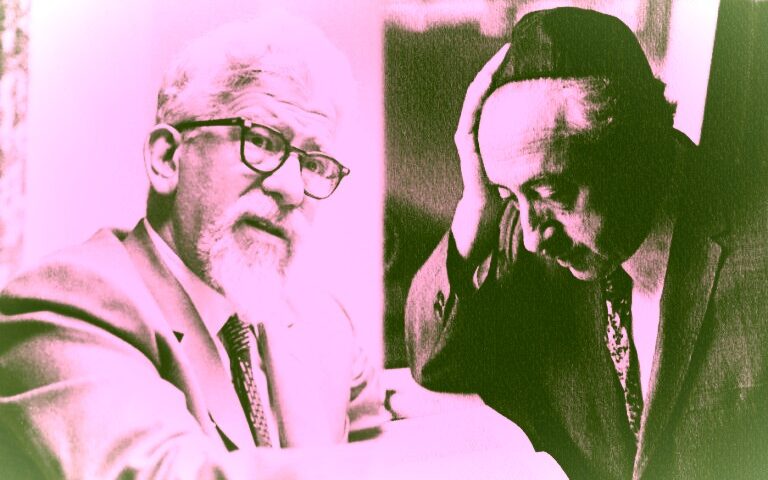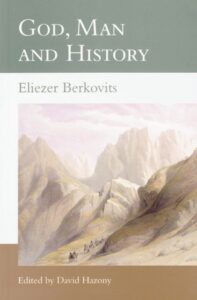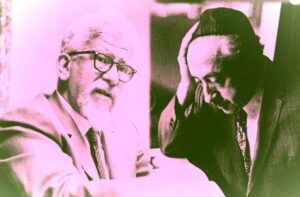RESPONSE: Considering “God, Man and History”

Responses to Todd Berman by David Curwin and Rafi Eis
Todd Berman’s recent TRADITION essay defending Abraham J. Heschel from a 1964 critique penned in our pages by Eliezer Berkovits has helped to revive a six-decade-old debate, no less relevant (or controversial) to today’s Jewish thought than it was back then. David Curwin and Rafi Eis push back on some aspects of Berman’s reading of Berkovits. Read Berman’s response to the following letters and read our editor’s deep-dive into relevant archival material which sets the stage and offers some context to the debate.
To the Editor:
R. Todd Berman has performed an important service in his recent essay, “Berkovits, Heschel, and the Heresy of Divine Pathos” (TRADITION, Fall 2022). Reintroducing R. Eliezer Berkovits’ 1964 essay to the public discourse and providing a thorough review of Dr. Abraham J. Heschel’s thought are both welcome contributions to TRADITION’s readership.
However, it seems to me that his analysis of the philosophy of R. Berkovits is somewhat one-sided and would benefit from some added balance.
Berman’s essay centers on justifying Heschel’s approach to “divine pathos” and questioning (or critiquing) Berkovits’ response to it. The focus on the 1964 essay is understandable, since it was the catalyst for Berman’s review. However, it is unfortunate that only on the 15th page of his essay did Berman cite Berkovits’ 1959 book God, Man and History, noting that “Reading Berkovits’ other theological writings increases the puzzle of his criticism of Heschel. . .Berkovits’ formulation seems surprisingly similar to Heschel” (65).
Not only did God, Man and History precede his critique of Heschel in the pages of TRADITION by several years, it should also be viewed as Berkovits’ most important presentation of his religious philosophy. Any full discussion of his approach to such issues as divine pathos and anthropomorphism must begin with it, and only later can it be asked why he offered the particular criticism of Heschel.
By centering his analysis on the TRADITION essay, Berman arrives at the conclusion that “Maimonides. . .who saw God in an Aristotelian and Platonic manner. . .as did Berkovits…” (54) and “many modern Jewish thinkers have internalized Maimonidean notions. . .Berkovits seems to begin from this rationalistic framework” (68). In the end of his essay, Berman posits that “Berkovits prefers a Maimonidean, or at least rationalistic-philosophic formulation, of God” (89).
Yet, if one begins by reading the earlier, and arguably more important, God, Man and History, the opposite conclusion becomes apparent. When Maimonides rejected the idea that God has human-like emotions (Guide I:54), Berkovits responded, “Now, this is an opinion that denies the most precious and intimate aspect of God’s relationship to the world and to man. The negative attributes will never do. Religion cannot forgo the love and mercy of God, or even his justice and anger.… What Maimonides denies God, namely affection and tenderness, are of the very essence of the encounter” (God, Man and History, 56-67).
In God, Man and History he also takes a softer approach to an anthropomorphic view of God. He distinguishes between “true anthropomorphism” which is “the making of God in man’s image,” and “anthropomorphism in quotation marks”—meaning “divine intentions and actions [that] may also be found among men.” The former must be rejected, but “the discovery of the likeness in men of the ‘relational attributes’ of God merely reflects the truth that man is formed in God’s image.” Berkovits goes so far as to say that “since God’s involvement in the destiny of man is the precondition of religion,” this type of “anthropomorphism” is inseparable from religion (65).
As to Berman’s claim that Berkovits is closer to the philosophy of Maimonides than to that of Yehuda Halevi (who he identifies with Heschel’s approach), this is refuted in the beginning of God, Man and History. Berkovits reserves unique praise for Halevi, writing, “In the present study, we will continue on a path that was pioneered by that ‘most Jewish of Jewish philosophers, Judah Halevi” and then notes that “To this day, [Halevi] has remained the solitary figure among Jewish philosophers of religion who succeeded in recognizing the independence of the religious realm, while nevertheless maintaining a healthy respect for the faculty of reason in its own domain” (11).
Berman is not the first to paint Berkovits as a disciple of Maimonides. A similar argument was made, also in reaction to the critique on Heschel in TRADITION, by Sol Tanenzapf in the journal Judaism (Summer 1974). In a response, R. Berkovits wrote:
The reader is therefore left with the impression that I am a ”Maimonidean.” Nothing could be further than the truth, as anyone may easily find by reading my God, Man and History, which was published several years prior to the publication of my criticism of Heschel in Tradition, in 1964 (Judaism, Winter 1975, 115-116).
In light of the above, the portrayal of Berkovits as a rationalist, Aristotelian, Maimonidean is misplaced. Of course, the question remains – if that is true, why then was he so critical of Heschel’s portrayal of divine pathos?
To understand this better, we need to review some passages from the 1964 essay that Berman did not include in his review. Notably, Berkovits initially concurs with Heschel: “we readily agree with the main burden of these thoughts.” Acknowledging the pervasiveness of such imagery in the biblical texts (as compared to the rejection of that approach by Greek philosophers), Berkovits credits Heschel’s approach to “the well-known distinction between the God of Abraham, Isaac and Jacob and the God of Aristotle; between the personal God of Judaism and the philosophical idea of the Absolute.” He adds that “it is correct to say that the conception of God as detached from the world and from man is ‘totally alien’ to the biblical mind” (79).
But that agreement does not mean he can accept all of Heschel’s claims. God’s involvement in the world does not indicate that He is indistinct from it, and God displaying apparent emotions does not mean He is human. Paraphrasing Heschel, Berkovits writes that “the fundamental challenge of Jewish theology throughout the ages has been how to reconcile the awareness of God’s transcendence with the awareness of God’s livingness and concern, which are one in the Jewish concept of God” (80).
Heschel, according to Berkovits, failed to maintain that equilibrium. The distinction between humans and God was not preserved. Every relationship—human to human or human to the Divine—requires each side to exist independently of the other. When the line between Creator and creation is blurred, there can be no real encounter.
Berkovits quotes Heschel: “it is because God is absolutely personal—devoid of anything impersonal—that this ethos is full of pathos.” But he cannot accept this claim. Rather, he asserts: “It is the very essence of God, God as He exists in His absoluteness and perfection, that determines the value of His care for man” (81).
While God is involved with and concerned for humanity, there can be no analogy or comparison between the human and the divine.
Even at the end of his essay, Berkovits acknowledges the value of Heschel’s contribution to this important philosophical discussion:
This episode of a “theology of pathos” in Judaism may, however, serve one useful purpose. It may point to the vital challenge that confronts contemporary Jewish theology. God is Infinite and Absolute and Perfect; yet, according to Judaism, the infinite, absolute and perfect God is related to the world and cares for His creation. How are the two aspects of Divine Reality to be related to each other? (102).
He admits that the question of how to reconcile God’s absolute perfection and changing emotions, His transcendence and His immanence, has no easy answer. He does not adjudicate on one side or another.
Keeping that balance is akin to treading a tightrope. Berkovits walked the same line. Like Heschel, he also built his theology on the Bible, emphasizing the centrality of the prophetic experience as a sign of God’s concern for humanity. Precisely because he agreed with Heschel, giving such importance to the “encounter,” he understood the danger of a misreading of sympathy. Equating God’s sympathy to man with man’s sympathy to God is dangerous. Berkovits was understandably concerned that Heschel was perilously close to the abyss, and so used admittedly intense arguments against this risk. This is particularly true regarding someone with the charisma of Heschel, who spoke to audiences beyond the confines of Orthodoxy. For those not steeped in the intricacies of Jewish scholarship, such an approach could lead to a dramatic divergence from traditional Judaism. The balance needs to be maintained, and to do so requires learning from both Halevi and Maimonides.
As Berkovits wrote in response to Tanenzapf:
While I am not at all a “Maimonidean,” I have gained from Maimonides an understanding of the very serious problems that are implied in any attempt at making statements about God.… I was only a critic, showing that Heschel wrote as if those problems raised by Maimonides did not exist at all, that one may freely ignore them.
Berkovits argued that Heschel was not operating with the caution that these topics demand. This is a far cry from Berman’s claim that “Berkovits’ main argument seems be that Heschel abandoned medieval rationalistic-philosophic assumptions, which form the framework of Jewish thought” (90).
Identifying Heschel with Halevi as opposed to Maimonides would be denied by Heschel himself. As he is quoted by Maurice S. Friedman: “Jewish thinking moves along two paths, that of critical thinking and that of imaginative reasoning – Maimonides and Yehuda Halevi […] I am both. I live these two trends” (Abraham Joshua Heschel & Elie Wiesel: You Are My Witnesses, FSG, 1987, 44).
No less credence should be granted to Rabbi Berkovits.
David Curwin writes about the origins of Hebrew words on his Balashon Blog, and about Jewish thought in TRADITION and elsewhere.
• • • • • • • • •
To the Editor:
In the most recent issue of TRADITION, R. Todd Berman published a lengthy essay defending R. Dr. Abraham Joshua Heschel’s theology of pathos from the attack of R. Dr. Eliezer Berkovits (an essay Berkovits originally published in TRADITION). Berman’s essay, however, defends Heschel by incorrectly describing Berkovits’ critique. Berkovits’ God, Man and History offers an extensive discussion of the relationship between God and man, and rejects the Aristotelian and Maimonidean position of the absolute God, as an unmoved mover who does not contemplate humanity. Instead, Berkovits believes that while there is the absolute God, Judaism also has the God of religion who “confronts man; he is a subject—and, at times, an object—for man” (God, Man and History, 58).
 Berman recognizes this and writes “reading Berkovits’ other theological writings increases the puzzle of his criticism of Heschel. In earlier works, Berkovits expresses similar notions to Heschel’s idea of divine pathos and concern for humanity.” Berman never explains the integration of Berkovits’ God, Man and History and his TRADITION essay, “Dr. A. J. Heschel’s Theology of Pathos,”, so it is not clear as to the dividing line between Berkovits and Heschel within Berkovits’ own thought.
Berman recognizes this and writes “reading Berkovits’ other theological writings increases the puzzle of his criticism of Heschel. In earlier works, Berkovits expresses similar notions to Heschel’s idea of divine pathos and concern for humanity.” Berman never explains the integration of Berkovits’ God, Man and History and his TRADITION essay, “Dr. A. J. Heschel’s Theology of Pathos,”, so it is not clear as to the dividing line between Berkovits and Heschel within Berkovits’ own thought.
Berman defends Heschel by including him in Judaism’s mystical tradition since “Outside of Kabbalah, Heschel’s interpretation falls apart. The tools of Jewish philosophy and theology have no room to admit any human characteristics such as emotions in God.” He cites numerous sources that support Heschel’s view. Marshaling Biblical and Talmudic sources to support Heschel is easy enough. The Bible describes God’s emotions at frequent intervals: God regrets, He gets angry, He loves and hates. Talmudic aggadot also describe God in such terms. At face value, Heschel is well within Jewish tradition. But accepting the first impression of Biblical and aggadic texts also leads to concluding that God has hands, feet, a back, a face, and eyes. For example, the Aramaic Brikh Shmei prayer, recited as the Torah is taken out for public reading, would support a central Christian contention that God has a son. Therefore, these verses have been clarified through interpretation for millenia by the Talmud and classic commentators. Berkovits mentions this point in his essay. Of course, there are different interpretive approaches, including rationalist, mystical, associative, and metaphorical. Importantly, being part of a rationalist school can still lead to differing interpretations and the same applies to other interpretive approaches. In which case, the sources cited by Berman do not suffice to defend Heschel and are in need an interpretive lens. That lens, or describing the differing lenses of Berkovits and Heschel, is analysis.
Any analysis requires a clear understanding of the primary sources. Analyzing Berkovits requires integrating his theology in God, Man and History with his critique of Heschel. When Berman analyzes the Berkovits-Heschel debate, however, he does so from his own framework, not from that of Berkovits. Berman writes that “Berkovits’ critique does a disservice to Hershel’s philosophy” since he “focus[ed] on a rationalist framework, while Heschel relies on a kabbalistic read of Jewish tradition.” But Berman misunderstands Berkovits and imposes rationalism on him. Berman similarly asserts that Berkovits is a medieval-type philosopher when he says that “Berkovits seems to begin from this rationalistic framework and, despite himself, refuses to read the biblical texts without a Hellenistic- philosophic perspective.”
The dichotomy of rationalist vs. mystic is not true for Berkovits since God, Man and History is a non-kabbalistic theology of man’s relationship with God. Berkovits did not view himself as a Maimonidean and does not resort to Kabbalah to explain God’s relationship with man. The result is that describing Berkovits as a Maimonidean (68, 89) might allow for an easier explanation of Heschel, but it is not a defense to Berkovits’ critique.
A second problem arises which Berman does not address. Jewish mysticism might explain Heschel, but Berkovits has significant hesitations about mysticism. His concern is not the classic rationalist critique of mysticism, since Berkovits posits that “all mysticism tends towards pantheism… [and] the appropriate worldview of the mystic is pantheism. It is his justification for devaluing individual existence” (God, Man and History, 40). Relying on a mystical approach does not offer Heschel an adequate defense. Berman should have addressed Berkovits’ concerns about mysticism.
In sum, getting to the depths of the argument requires understanding Berkovits on his own terms. When responding for Heschel, Berman would need to directly address at least one of Berkovits’ assertions. This could lead to different perspectives on the nature of the God-human relationship. They could also argue about whether mysticism and pantheism are inherently linked. Such an analysis would be valuable and relevant for the increasing number of Jews that have accepted Kabbalistic ideas and practices.
Rabbi Rafi Eis is the Executive Director at the Herzl Institute.

